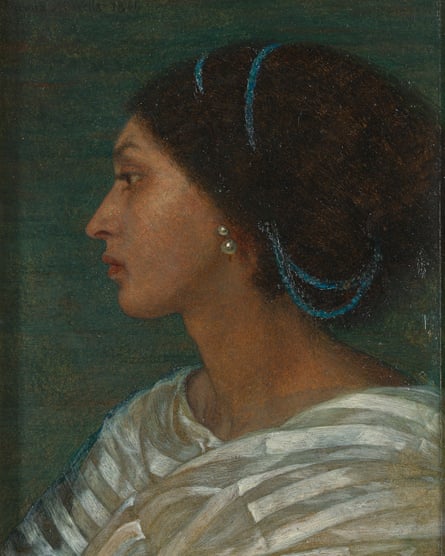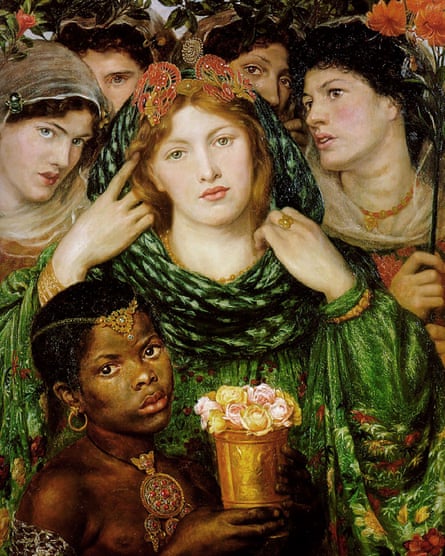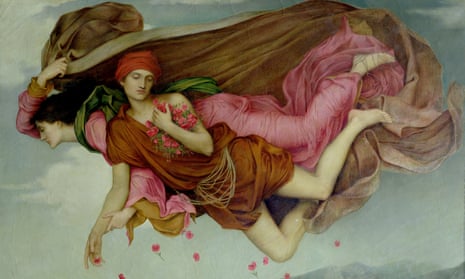At first glance, Queen Eleanor and Fair Rosamund looks like a classic piece of pre-Raphaelite art. It shows the moment when Henry II’s queen Eleanor, according to legend, discovers her husband’s sequestered mistress in her secret hiding place and dramatically offers Rosamund the choice of death by dagger or poison. The scene was a firm favourite with Dante Gabriel Rossetti and Edward Burne-Jones. It had everything: the opportunity to go full-medieval, with leaded gothic windows and flowing gauzy gowns and Rosamund’s unloosed wavy red hair. The allegorical binaries, too, could be laid on thick – enraged Eleanor is accompanied by a diabolic crew of apes and lizards, while cowering Rosamund is circled by fluttering doves and cupids. Finally, there was the irresistible chance to work with a magnificent colour palette – all those ruby reds and golds glowing as if they had been transferred straight from a 14th-century psalter.
This painting, though, is not by one of the big boys of pre-Raphaelite art. It is the work of Evelyn De Morgan, a woman whose painting was often compared to that of Burne-Jones. Sir Edward, indeed, was scathing about the young artist in his private letters, a sure sign that he felt rattled by her talent. She had been a big success at the Grosvenor Gallery, which was generally regarded as Burne-Jones’s own manor. And even in De Morgan’s earlier pieces, such as the luscious Night and Sleep (1878) made when she was just 23, you sense the painterly confidence and feeling for colour that might make any established grandmaster look to his laurels.

De Morgan is one of a dozen women whose work is celebrated in the National Portrait Gallery’s autumn show Pre-Raphaelite Sisters. Incredibly, this is the first time that there has been an exhibition dedicated to the work of the female painters, makers, models and managers associated with the movement that disrupted British art in the second part of the 19th century. Indeed, canonical exhibitions of pre-Raphaelite art, such as the landmark exhibition at the Tate in 1984, have routinely relegated women to minor roles as muses, lovers and disappointed wives. While recent revisionary scholarship has begun to reclaim Lizzie Siddal’s ambitions as a painter and Jane Morris’s work as an expert needleworker, the two first ladies of pre-Raphaelitism still mostly get written up through their tortured private lives and dismal marriages to Rossetti and William Morris respectively.
“In this exhibition we wanted to restore agency to the many women associated with the pre-Raphaelite story whose contributions have never been fully acknowledged,” explains Jan Marsh, co-curator of the show. What Marsh and her colleague Alison Smith triumphantly demonstrate is not only that women produced work that was easily the equal of their male friends, brothers and uncles, but that they did so with the full self-consciousness of professional artists. De Morgan is a case in point. She was born in 1855, the granddaughter of an earl, into the kind of wealthy upper-class background where women were expected to stay conspicuously leisured. Yet rather than embarking on the life of a debutante, De Morgan took herself off to the Slade, where she proceeded to scoop a scholarship and win other glittering prizes. She also developed a rigorous practice that required her to get up early in the morning to paint before powering through to the end of the day. Not only was her work admired by the critics, she made a healthy income from selling large paintings to high-profile patrons, including MPs and industrialists. This was lucky, because her husband, the delightful but unworldly ceramicist William De Morgan, depended on her income to keep their merry, unpretentious household ticking over.
By the time Evelyn De Morgan was working at the end of the 19th century, attitudes towards female professional artists were shifting. Twenty-five years earlier, Joanna Boyce, who belonged to the same generation as the original pre-Raphaelites Rossetti, John Everett Millais and William Holman Hunt, was obliged to battle conventional attitudes, including her own. It was not until she had already had several paintings accepted at the Royal Academy summer show, including a wonderfully soulful portrait of Elgiva, a murdered Anglo-Saxon queen, that Boyce found the confidence to travel to Paris and sign up for “a ladies’ class” at the atelier of Thomas Couture. Here she was permitted to draw from nude models, discovering in the process that there was nothing to feel embarrassed about: “Any girl may draw as I have been drawing yesterday and this morning, as free from harm or any danger of it, as though they studied a bunch of flowers or a landscape.”
Being in Paris also allowed Boyce to flourish as an art critic, and she sent home trenchant reviews to the prestigious Saturday Review, unafraid to upset sacred cows in the process. She declared Jean-Auguste-Dominique Ingres, the current darling of the French public, to be ‘‘[a]n execrable draftsman, a bad colorist, a man with no intensity of feeling or power of imagination, how has he attracted such a crowd of worshippers?”

How ironic that Boyce’s brilliant life and career were cut short at just 29 by that enduring feature of a woman’s life – childbirth. Like De Morgan a generation later, Boyce resisted marriage for years because she feared family life would distract from her art. But in 1857 she finally accepted a proposal from her devoted admirer Henry Wells, a portrait artist. Just four years later Joanna Boyce Wells was dead, days after giving birth to her third child. Rossetti, her brother’s best friend, was summoned to take a final sketch, and could be heard murmuring later: “A great artist sacrificed to bringing more kids into the world.”
One of the most unlikely life stories to be celebrated in the exhibition is that of Fanny Eaton, a Jamaican-born model. For decades Eaton was “hiding in plain sight” in the work of the pre-Raphaelites of the 1860s. Rossetti’s The Beloved (1865) is the most famous picture she appeared in, as the bridesmaid with dark skin. But art historians have also identified her as the model in Albert Moore’s The Mother of Sisera (1861) and Simeon Solomon’s The Mother of Moses (1860). Solomon’s sister Rebecca, meanwhile, used Eaton as her model for the Indian ayah in her painting of 1861 The Young Teacher, while for Frederick Sandys she was the medieval temptress Morgan le Fay.
As this huge spread of proxy identities suggests, the pre-Raphaelites were happy to use Eaton, who was the daughter of a black slave and (probably) a white plantation owner, as a placeholder for a whole range of ethnicities. She could be Palestinian, Egyptian or Libyan as required. On one occasion she was turned into an African American and on another into a west African slave. The one thing she was never permitted to be was mixed-race Jamaican.
Little is known about Eaton’s life, although her descendants – who had no idea that they had black ancestry – are beginning to piece her story together through the usual family history channels. She arrived in London with her mother, Matilda, in the 1840s and went to work as a charwoman. In 1857 she married a cab driver called George Eaton, with whom she had 10 children. It seems likely that becoming a professional model for the pre-Raphaelite circle was a matter of pride and profit for Eaton. There is nothing to suggest that she was sexually involved with any of the painters (the same could hardly be said of so many of the other working-class models including Siddal, Morris, Fanny Cornforth and Annie Miller). Rather, says Marsh, what we seem to have here is a unique example of a woman of colour using her ethnic ambiguity to forge a profitable career as a professional worker in the art world. For this reason alone, Eaton takes up her place with the other 11 pre-Raphaelite sisters as a true pioneer.
